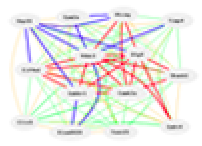| |
|
|
|
|
|
|
|
|
|
|
|
|
Welcome! Login
|
|
Data Set Group2: GSE15745 GPL6104 NIH Human Brain ILM humanRef-8 v2.0 (May10) RMA

Data Set: GSE15745 NIH Human Brain Prefrontal Cortex ILM humanRef-8 v2.0 (May10) RankInv  |
| GN Accession: GN482 |
| GEO Series: GSE15745 |
| Title: Integration of GWAS SNPs and tissue specific expression profiling reveal discrete eQTLs for human traits in blood and brain. |
| Organism: Human (Homo sapiens, hg19) |
| Group: Brain-Normal-NIH-Gibbs |
| Tissue: Prefrontal Cortex mRNA |
| Dataset Status: Public |
| Platforms: Illumina humanRef-8 v2.0 expression beadchip (GPL6104) |
| Normalization: RankInv |
|
| Contact Information |
J Raphael Gibbs
National Institutue on Aging, NIH
35 Convent Drive, Bldg 35/1A1015, MSC3707
Bethesda, MD 20892 USA
Tel. 301 451 6094
gibbsr@mail.nih.gov
Website
|
| Download datasets and supplementary data files |
|
|
|
|
| Specifics of this Data Set: |
None
|
| Summary: |
| Summary from GEO Series GSE36192 and GSE: GSE36194 "A fundamental challenge in the post-genome era is to understand and annotate the consequences of genetic variation, particularly within the context of human tissues. We describe a set of integrated experiments designed to investigate the effects of common genetic variability on mRNA expression distinct human brain regions. We show that brain tissues may be readily distinguished based on expression profile. We find an abundance of genetic cis regulation mRNA expression. We observe that the largest magnitude effects occur across distinct brain regions. We believe these data, which we have made publicly available, will be useful in understanding the biological effects of genetic variation."
|
| About the cases used to generate this set of data: |
|
| About the tissue used to generate this set of data: |
|
| About the array platform: |
|
| About data values and data processing: |
|
| Notes: |
|
| Experiment Type: |
| North American Brain Expression Consortium and UK Human Brain Expression Database: Gene Expression. Genome-wide association studies have nominated many genetic variants for common human traits, including diseases, but in many cases the underlying biological reason for a trait association is unknown. Subsets of genetic polymorphisms show a statistical association with transcript expression levels, and have therefore been nominated as expression quantitative trait loci (eQTL). However, many tissue and cell types have specific gene expression patterns and so it is not clear how frequently eQTLs found in one tissue type will be replicated in others. In the present study we used two appropriately powered sample series to examine the genetic control of gene expression in blood and brain. We find that while many eQTLs associated with human traits are shared between these two tissues, there are also examples where blood and brain differ, either by restricted gene expression patterns in one tissue or because of differences in how genetic variants are associated with transcript levels. These observations suggest that design of eQTL mapping experiments should consider tissue of interest for the disease or other traits studied. Published by Elsevier Inc.
|
| Contributor: |
|
| Citation: |
| Please review and cite: Gibbs JR, Hernandez DG, Dillman A, Ryten M, Trabzuni D, Traynor BJ, Nalls MA, Arepalli S, Ramasamy A, van der Brug MP, Troncoso J, Johnson R, O'Brien R, Zielke HR, Zonderman A, Ferrucci L, Longo DL, Smith C, Walker R, Weale M, Hardy JA, Cookson MR, Singleton AB. PMID: 22433082.
|
| Data source acknowledgment: |
|
| Study Id: |
180
|
|
|

|
Web services initiated January, 1994 as Portable Dictionary of the Mouse Genome; June 15, 2001 as WebQTL; and Jan 5, 2005 as GeneNetwork.
This site is currently operated by
Rob Williams,
Pjotr Prins,
Zachary Sloan,
Arthur Centeno. Design and code by Pjotr Prins, Zach Sloan, Arthur Centeno, Danny Arends, Christian Fischer, Sam Ockman, Lei Yan, Xiaodong Zhou, Christian Fernandez, Ning Liu, Rudi Alberts, Elissa Chesler, Sujoy Roy, Evan G. Williams, Alexander G. Williams, Kenneth Manly, Jintao Wang, and Robert W. Williams, colleagues.
|

|

|
GeneNetwork support from:
- The UT Center for Integrative and Translational Genomics
- NIGMS Systems Genetics and Precision Medicine project (R01 GM123489, 2017-2021)
- NIDA NIDA Core Center of Excellence in Transcriptomics, Systems Genetics,
and the Addictome (P30 DA044223, 2017-2022)
- NIA Translational Systems Genetics of Mitochondria, Metabolism, and Aging (R01AG043930, 2013-2018)
- NIAAA Integrative Neuroscience Initiative on Alcoholism (U01 AA016662, U01 AA013499, U24 AA013513, U01 AA014425, 2006-2017)
- NIDA, NIMH, and NIAAA (P20-DA 21131, 2001-2012)
- NCI MMHCC (U01CA105417), NCRR, BIRN, (U24 RR021760)
|
|
It took 0.062 second(s) for tux01.uthsc.edu to generate this page
|
|







